Roger's Scenario Thread
-
Name Great Northern War
Description The Great Northern War
https://axisandallies.fandom.com/wiki/Great_Northern_War
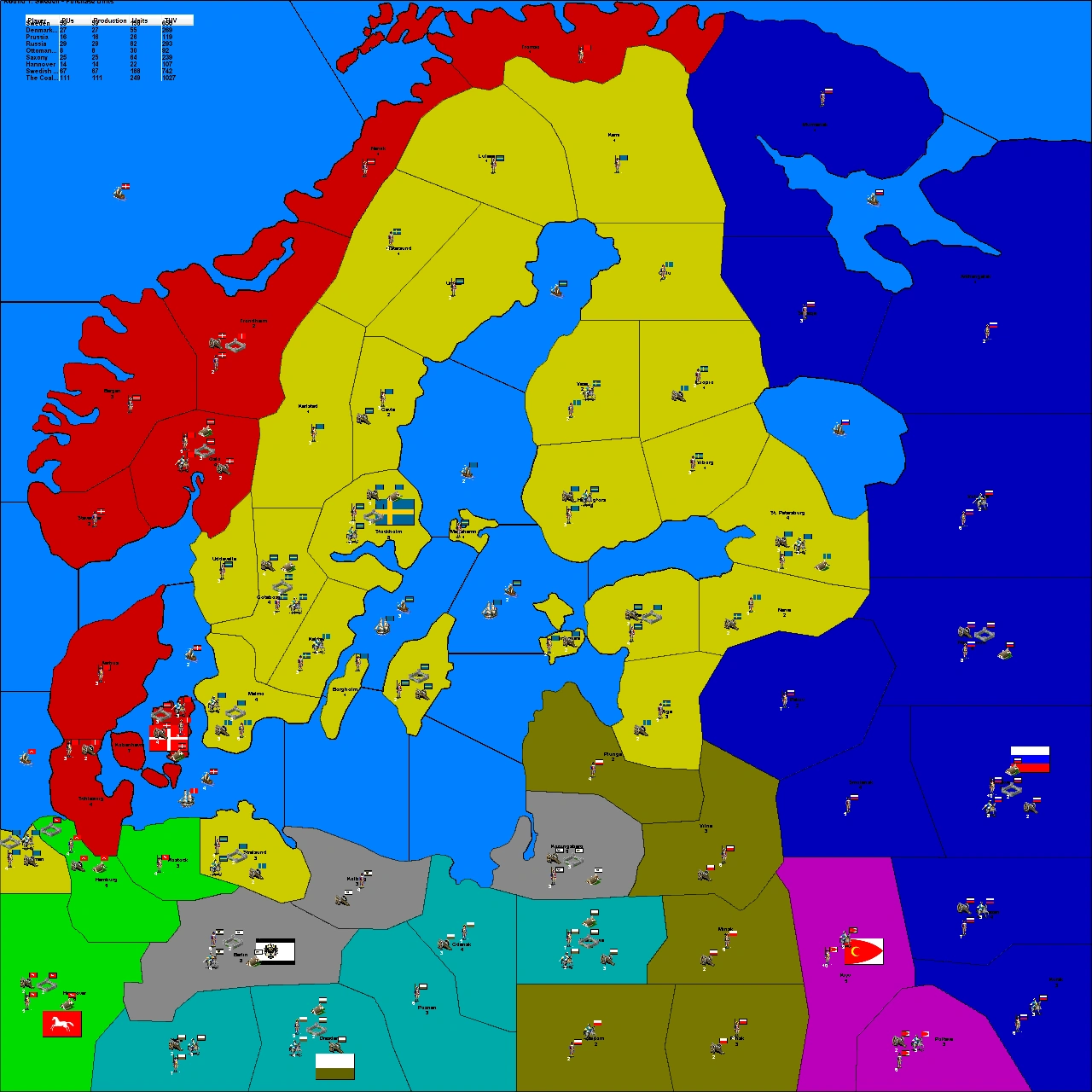
Good Points
- Not just another WW2 game
Bad Points
- The Swedes have little chance
- No sense of the realities of 18th century warfare or the tactical skill of Charles XII
-
Name Napoleonic Empires
Description The Napoleonic Wars
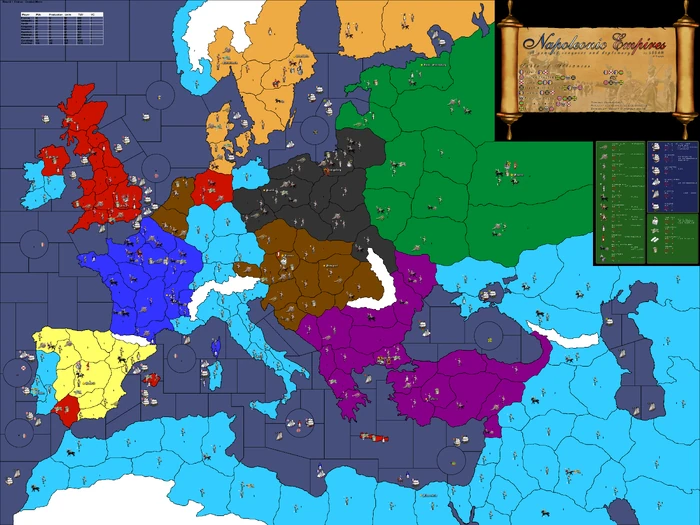
https://axisandallies.fandom.com/wiki/Napoleonic_Empires_(Main_Scenario)Good Points
- Conflict all over the map
- Reasonably balanced
- Pretty Units
Bad Points
- No sense of actual Napoleonic War operations and tactics
- None of the diplomatic points of the war
-
@rogercooper I'll add that a Napoleonic scenario simply cannot be a two-sided (1v1) game unless it both starts very late (like in 1812, at the start of the invasion of Russia) and has 1940-like delays for factions actively to join in the war. A simple two-sided game would work for the Hundred Days (War of the Seventh Coalition).
Having an early Napoleonic game as a simple 1v1 with no delays and no politics makes no sense: it needs to be a FFA or at least a game with many sides.
-
@cernel said in Roger's Scenario Thread:
@rogercooper I'll add that a Napoleonic scenario simply cannot be a two-sided (1v1) game unless it both starts very late (like in 1812, at the start of the invasion of Russia) and has 1940-like delays for factions actively to join in the war. A simple two-sided game would work for the Hundred Days (War of the Seventh Coalition).
Having an early Napoleonic game as a simple 1v1 with no delays and no politics makes no sense: it needs to be a FFA or at least a game with many sides.
This was one of the first TripleA mods. Now, there are tools that could handle some of the politics of the Napoleonics Wars, as well as some of its operational characteristics (give Napoleon the ability to increase the movement of units stacked with him). However, if I want area movement Napoleonic Wars, I could play Victory & Glory..
-
Name World War 2- Zombies
Description Based upon the game Axis & Allies & Zombies
https://axisandallies.fandom.com/wiki/Zombies-World_War_2
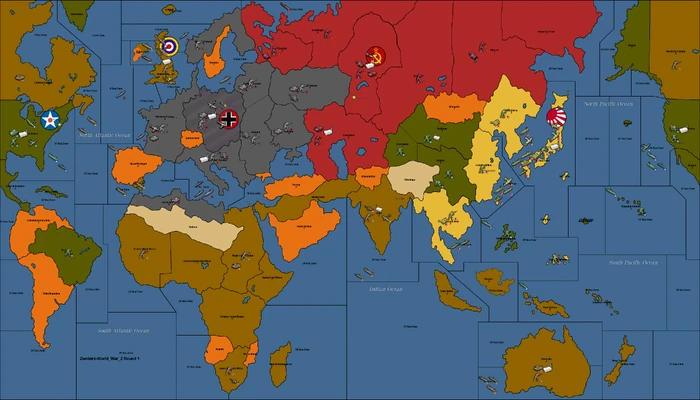
Good Points
- Randomly appearing zombies keeps the player on their toes
- One turn limit in ground combat, keeps the game at a more measured pace
- Infantry-only factories in Asia are interesting
Bad Points
- Doesn't implement many of the rules of AAZ
- The AI has trouble handling many of the rules
-
Name 300BC
Description The Mediterranean in 300 BC
https://axisandallies.fandom.com/wiki/300_BC
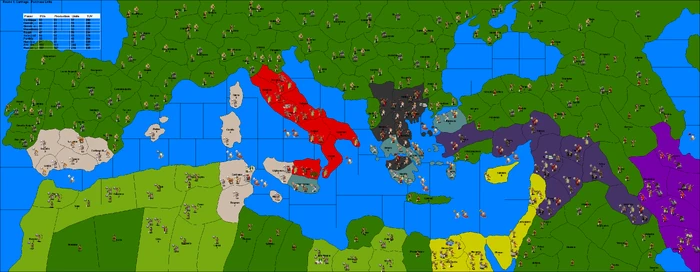
Good Points
- Nice unit images
- Not another WW2 game
Bad Points
- No feel for the realities of ancient warfare
- Strongly favors the Romans
-
@rogercooper said in Roger's Scenario Thread:
- Strongly favors the Romans
How did you come to that conclusion? I've never played it, yet I would rather say that the game is quite clearly in favour of Anti Roman if only because here Anti Roman is relatively much more powerful than in 270BC as a matter of starting quantities, because "warelephant" is both more powerful and less costly and because ships with movement 2 instead of 1 over-advantage Anti Roman even more if nothing else.
Is it that you actually believe that 270BC favours Roman even more strongly that this one?
I would also add "bad units balance for some of the units" amongst the bad points.
Do you ever buy "horsearcher" here? Beside horsearchers, other units (like "hoplite", "chariot" and "cataphract") are seriously under-powered (or over-priced).
-
@cernel I played 300BC both as a human and with the AI taking all sides. The problem is the isolation of the Seleucids. They start facing both Parthia & Egypt. Numidia is too weak and Carthage too distance to put enough pressure on Egypt to divert them from the Seleucids. Once the Anti-Romans rule the East, Rome is too behind in the income game.
270BC has the same problem. It can be interesting the play as the Romans against the AI, where a human player can generate enough momentum to make for the loss of their eastern ally.
The units are not well balanced and are not sufficiently differentiated between the nations.
There is also almost no strategic feel of pre-industrial warfare. Take a look at Greyhawk Wars for a game that does it right (within the limitations of the TripleA engine).
-
@rogercooper said in Roger's Scenario Thread:
There is also almost no strategic feel of pre-industrial warfare.
Since I'm making a game set in 1176 Europe, West Asia and North Africa (the year of the battles of Legnano and Myriokephalon), I'm curious in what is your list of things which should be part of a TripleA pre-modern game and what you believe should also be part of the same but is not possible in TripleA.
On 300BC, I'm at least as sure as I can be (without having played it) that that game is a lot more in favour of Anti Roman than 270BC, so I much doubt that it can be unbalanced in favour of Roman. It may be that you just didn't figure out how to play Seleucids very well, capitalizing on those offence/defence 1/1 and cost 2 units (the most cost-effective units in the game).
-
@rogercooper said in Roger's Scenario Thread:
270BC has the same problem. It can be interesting the play as the Romans against the AI, where a human player can generate enough momentum to make for the loss of their eastern ally.
I assume that here you got confused and actually meant "play as the Anti Romans", correct?
-
@cernel No, as the situation is biased against the Romans, playing the Romans is interesting. If played correctly, the Romans are knocking out the Macedonians before the Seleucids fall.
-
@cernel said in Roger's Scenario Thread:
@rogercooper said in Roger's Scenario Thread:
There is also almost no strategic feel of pre-industrial warfare.
Since I'm making a game set in 1176 Europe, West Asia and North Africa (the year of the battles of Legnano and Myriokephalon), I'm curious in what is your list of things which should be part of a TripleA pre-modern game and what you believe should also be part of the same but is not possible in TripleA.
Doable in TripleA
- Upkeep costs - Keeping armies in the field was expensive for all pre-modern states
- Stacking limits - The ability to keep armies fed limited their size
- Local forces - Under a 'feudal' system, forces were available locally for effectively no cost
- Fortifications - The difference between siege warfare and field warfare was important.
- Command Limits - Limiting the number of units that can be moved (which can mess up the AI)
Not doable in TripleA
- A more sophisticated combat model like in "Block" games
- A better consideration of events like in Card-driven wargames
- The way that mobile campaigns could sometimes be conducted
- Flexible rules for diplomacy and alliances
-
@rogercooper said in Roger's Scenario Thread:
@cernel No, as the situation is biased against the Romans, playing the Romans is interesting. If played correctly, the Romans are knocking out the Macedonians before the Seleucids fall.
I'm not sure I'm following you any longer or ever. Regarding 300BC, you said
@rogercooper said in Roger's Scenario Thread:
- Strongly favors the Romans
How can you say that 300BC strongly favours the Romans and then say that 270BC is biased against the Romans (if this is the case)? If anything, I think it is very clear that the Anti Roman Alliance is much better off in 300BC than in 270BC (for the reasons I've explained), that is I think that it is clear that the Anti Roman Alliance got "nerfed" going from 300BC to 270BC.
I originally assumed that by "the Romans" you meant the Roman Alliances (name changed to "Roman Alliance" in 270BC). Were you instead talking about the Roman Empire (name changed to "Roman Republic" in 270BC)? Are you now talking about the Roman Alliance or the Roman Republic when you say "the Romans"? Are we now talking about 270BC or 300BC?
I suggest avoiding using the name "Romans" in favour of the "Roman Alliances", the "Roman Alliance", the "Roman Empire" or the "Roman Republic". If you can backtrack and tell me what of those four were you referring to in the previous posts whenever you said "Romans", that is likely going to be helpful for me to understand you better.
-
@rogercooper said in Roger's Scenario Thread:
@cernel said in Roger's Scenario Thread:
@rogercooper said in Roger's Scenario Thread:
There is also almost no strategic feel of pre-industrial warfare.
Since I'm making a game set in 1176 Europe, West Asia and North Africa (the year of the battles of Legnano and Myriokephalon), I'm curious in what is your list of things which should be part of a TripleA pre-modern game and what you believe should also be part of the same but is not possible in TripleA.
Doable in TripleA
- Upkeep costs - Keeping armies in the field was expensive for all pre-modern states
- Stacking limits - The ability to keep armies fed limited their size
- Local forces - Under a 'feudal' system, forces were available locally for effectively no cost
- Fortifications - The difference between siege warfare and field warfare was important.
- Command Limits - Limiting the number of units that can be moved (which can mess up the AI)
Not doable in TripleA
- A more sophisticated combat model like in "Block" games
- A better consideration of events like in Card-driven wargames
- The way that mobile campaigns could sometimes be conducted
- Flexible rules for diplomacy and alliances
Very interesting list. I'll keep it as a reference for my game.
I would add also the fact that TripleA does not support land units impacting naval warfare while being cargo. In the age of sails and even more so before gun-powder became important in naval battles, what the ship was transporting would have influenced its combat prowess because the land units in the ships possibly were an important part of the actual combatants. For example, a ship transporting archers would be stronger in naval battles than the same ship transporting mostly horses.
An other limit is that TripleA does not support different types of cargo. For example, horses should be more easily transported by horse-transports than by other ships, so the horse unit should have a bigger size for the other ships than for the horse-transports or even being impossible to load regardless of its size.
I think that "stacking limits" should go in the "non-doable" list. It doesn't make sense to have the same limit unless every territory has the same production or such and it should not be a hard limit but rather timed. For example, you could spread out your armies so that they can live off the land and concentrate them at a same location just before a battle (even though they cannot stay there but for a few days without starving). However, I think that this limit is scarcely necessary for the high middle ages while the army is in a friendly territory because armies were quite small back then and were mostly paying for their stuff, so merchants would likely privately satisfy most needs thus siphoning stuff from other areas towards the armies.
By the way, cards are doable as long as everyone knows the card after it has been drawn: you can have a (fake) territory per card and use the random placement to decide what card somebody is getting. Such territories would be not real territories and connected to nothing so useless for the actual game, of course. For example, the card system of Risk would be 100% doable except for everyone knowing what cards you have in your hand.
Can you explain what you mean by "a more sophisticated combat model like in "Block" games"?
-
I would add also the fact that TripleA does not support land units impacting naval warfare while being cargo. In the age of sails and even more so before gun-powder became important in naval battles, what the ship was transporting would have influenced its combat prowess because the land units in the ships possibly were an important part of the actual combatants. For example, a ship transporting archers would be stronger in naval battles than the same ship transporting mostly horses.
A good point but there was always a distinction between combat ships and transport ships.. You can assume that any combat ship has enough troops to be effective.
An other limit is that TripleA does not support different types of cargo. For example, horses should be more easily transported by horse-transports than by other ships, so the horse unit should have a bigger size for the other ships than for the horse-transports or even being impossible to load regardless of its size.
TripleA can handle that. Just give horses a higher transport cost, so high that only dedicated transports can carry them. Note that there were no dedicated horse transports, instead existing merchants ships woudld be modified.
I think that "stacking limits" should go in the "non-doable" list. It doesn't make sense to have the same limit unless every territory has the same production or such and it should not be a hard limit but rather timed. For example, you could spread out your armies so that they can live off the land and concentrate them at a same location just before a battle (even though they cannot stay there but for a few days without starving). However, I think that this limit is scarcely necessary for the high middle ages while the army is in a friendly territory because armies were quite small back then and were mostly paying for their stuff, so merchants would likely privately satisfy most needs thus siphoning stuff from other areas towards the armies.
Armies were not always so small. Mega-stacks are not realistic in WW2 but even less so in pre-industrial armies. Check out the stack tax of Greyhawk wars.
By the way, cards are doable as long as everyone knows the card after it has been drawn: you can have a (fake) territory per card and use the random placement to decide what card somebody is getting. Such territories would be not real territories and connected to nothing so useless for the actual game, of course. For example, the card system of Risk would be 100% doable except for everyone knowing what cards you have in your hand.
That would more easily handled by random events which TripleA can do. CDW's are often more sophisticated.
Can you explain what you mean by "a more sophisticated combat model like in "Block" games"?
I suggest picking up the game Blocks!: Julius Caesar either on Steam or the physical board game. This game has a number of clever features despite fairly simple rules. The combat model is a clear improvement on TripleA. (note that the AI the computer version is weak) -
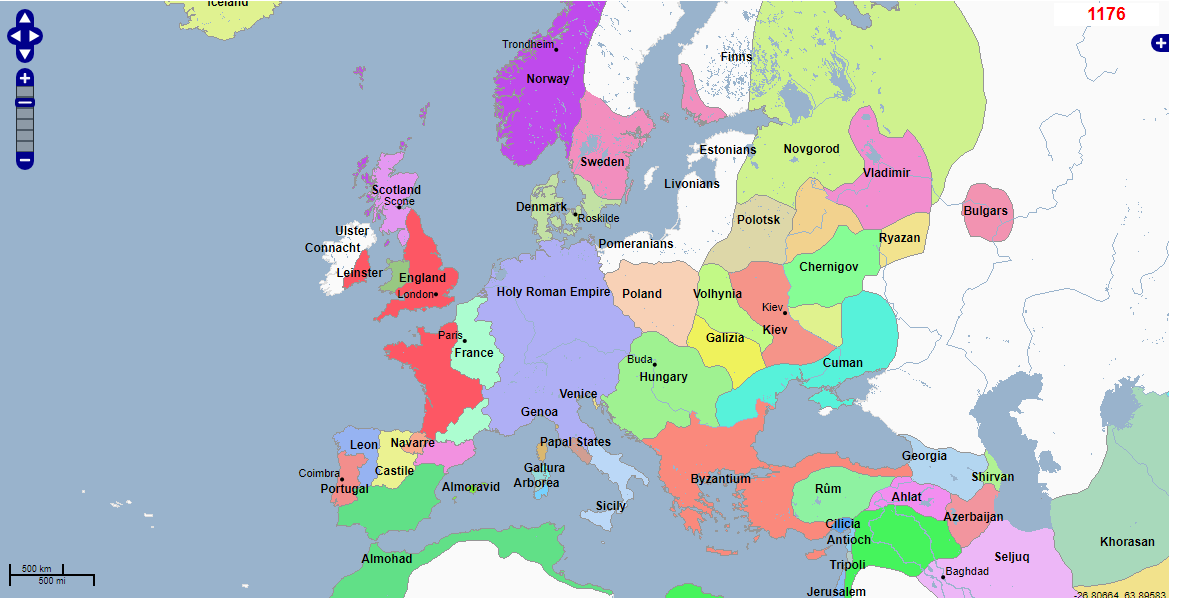
-
@rogercooper Thanks for the interest and feel free to show more, but this map is approximative and also quite wrong. I can easily spot over 10 mistakes in it if this is meant to be 1176 (but it is not too bad just to have a broad view at the big picture).
-
@cernel This is from the geacron.com. I have a better quality map at Centennia Historical Atlas, but I am having trouble getting it to work now. I will post the map when I get it to work..
Good luck on your mod. Here is a more detailed Mediterranean focused map.
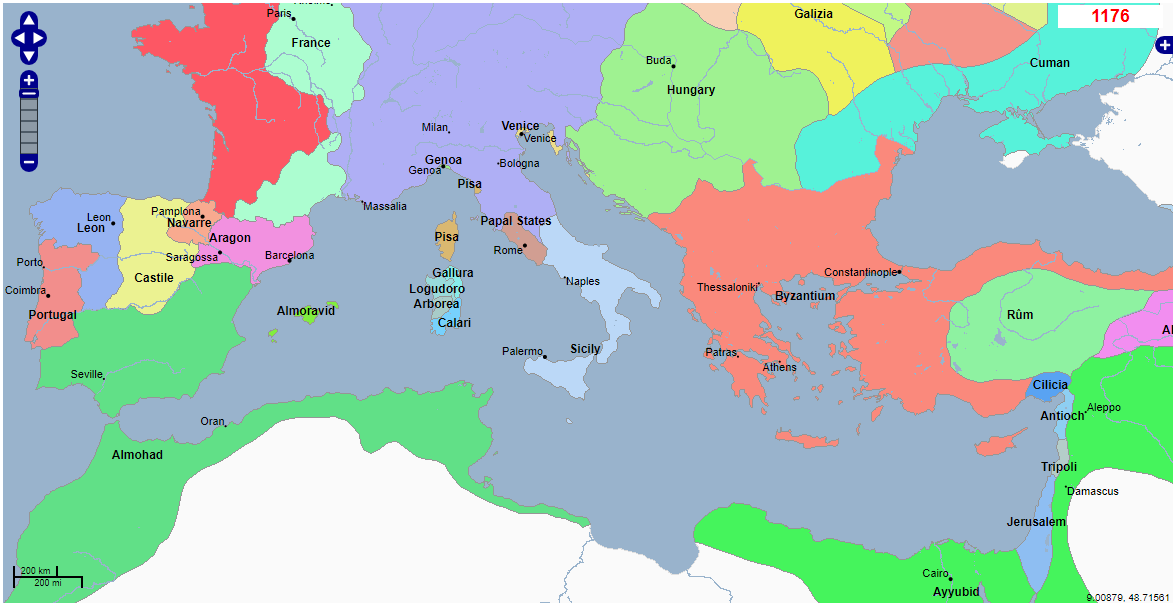
-
This map was drawn in 1154.
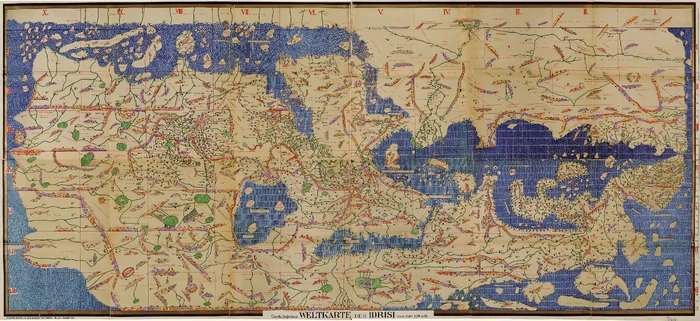
-
@rogercooper Yes, I know the map of Ruggero Altavilla (as it is called in Italian), actually made for him by a Muslim. I was actually thinking to use it to create the relief tiles for my game, but I could not find a version of this map big enough for it. If I make repeating tiles which are too small, then it is very apparent that they keep repeating itself (so it's lame), so I would need a very big image of the map you posted (something like the image you posted but 20,000 pixels wide or more and of very good quality).
My map itself spans from the 24.02 to the 64.02 parallel and from the -10.77 to the 51.73 meridian. Practically, the borders are given, on the south, by the first cataract of the Nile and, on the east, by the mouth of the Ural river. This means that the border on the south is a parallel about in the middle of the Sahara desert and the border on the east is a meridian about in the middle of the Caspian sea. On the north the map is extended to comprise at least enough around Trondheim, and on the west the map is extended to comprise all mainland Ireland so all continental western Europe as well.
I chose the equirectangular projection.